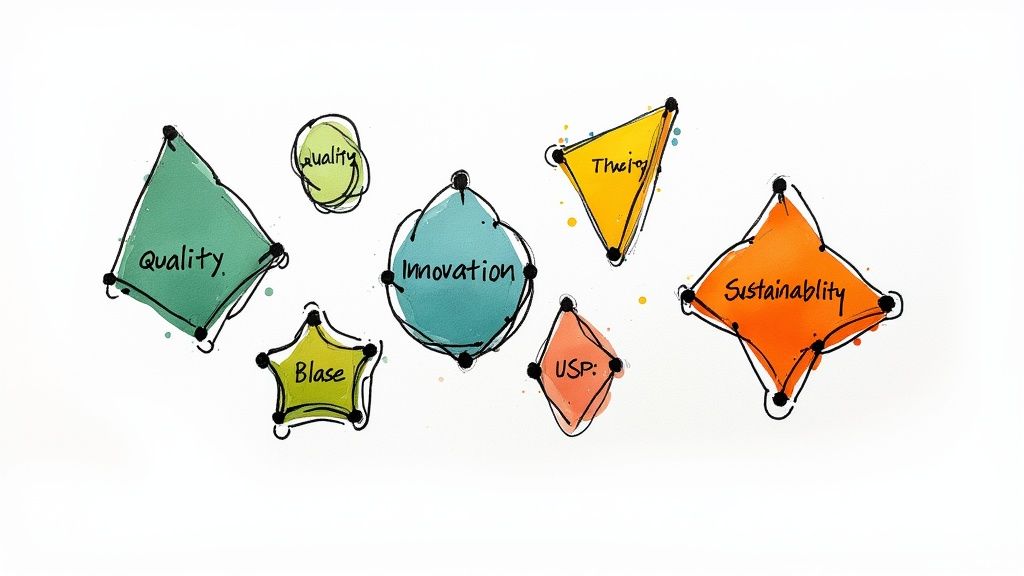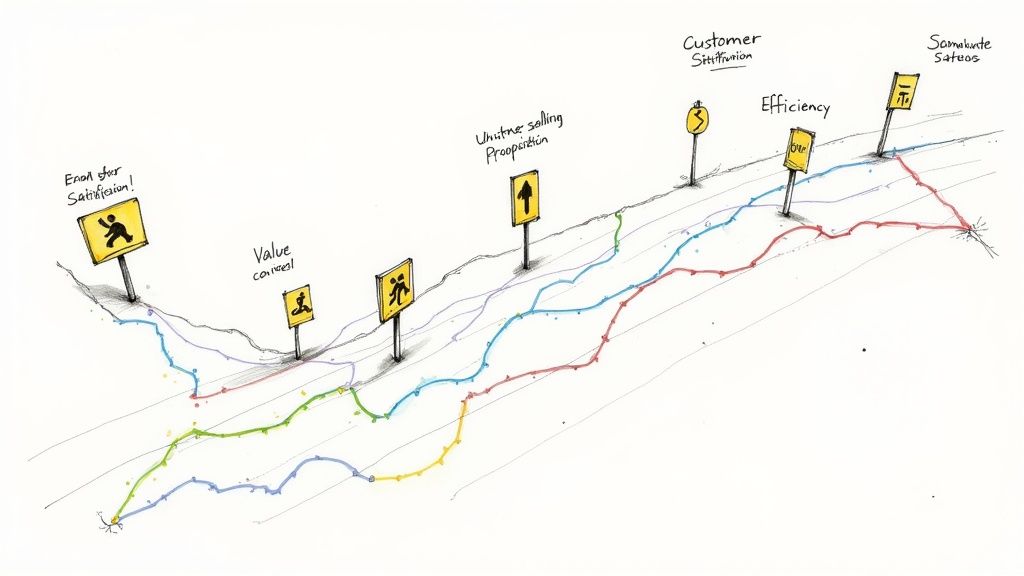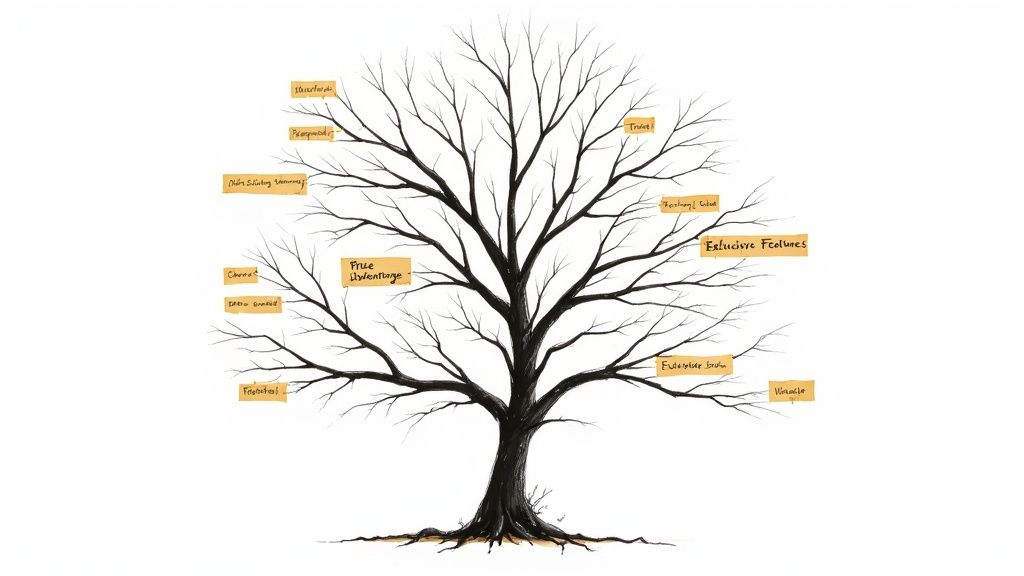Understanding the Strategic Power of Unique Selling Propositions

A unique selling proposition (USP) gives your business its competitive edge. It’s the clear reason why customers should choose your brand over others. For e-commerce businesses on platforms like Shopify and WooCommerce, where competition keeps growing, a strong USP helps attract and keep loyal customers while driving consistent sales growth.
Think of your USP as the foundation that supports all your marketing activities. It shapes how you communicate with customers and builds your brand identity. Take two coffee shops as an example – one simply advertises “coffee,” while another offers “ethically sourced, small-batch roasted coffee for the discerning palate.” The second shop speaks directly to customers who care about quality and ethical production.
The USP concept has an interesting history, starting in the 1940s with advertising pioneer Rosser Reeves. He showed how highlighting specific product benefits could drive successful ad campaigns, a principle that still works well for today’s online businesses. Learn more about USP history here.
Why Are Unique Selling Propositions Essential for Modern Businesses?
A strong USP delivers three key benefits:
- Customer Acquisition: It quickly shows potential customers why they should pick your brand, making their choice easier
- Brand Differentiation: It helps your business stand out in crowded markets by highlighting what makes you special
- Increased Customer Loyalty: When customers connect with your USP, they’re more likely to come back and buy again, strengthening your customer relationships
Moving Beyond Generic Claims: Crafting USPs that Resonate
Many businesses fall into the trap of using vague statements like “high quality” or “excellent customer service” as their USP. These claims are too general to make your brand memorable. Instead, focus on specific benefits that matter to your target customers.
For example, MyAdForce doesn’t just say it’s “easy to use.” The platform specifically promises “rapid creation of effective sales tunnels without advanced digital marketing skills.” This clear message speaks directly to business owners who want straightforward advertising solutions.
When you identify what truly sets you apart and explain it clearly, your USP connects with the right customers and helps build lasting success for your business.
Mapping Your Target Audience’s Deep-Seated Needs

A compelling unique selling proposition (USP) goes far beyond listing product features. The key is understanding what truly drives your customers to make buying decisions. By diving deep into their real-world challenges and desires, you can uncover insights that shape a USP that resonates. Take the example of shoe buyers – knowing their age and income tells only part of the story. Understanding how shoes fit into their daily life and what they value most reveals the real opportunities.
Identifying Core Motivations and Pain Points
Top companies invest significant time in learning about their customers through multiple channels. They run focused surveys, conduct in-depth interviews, and analyze social media discussions to spot emerging needs. This research reveals specific problems their products can solve. By also studying competitor offerings, they find gaps where they can provide unique value to customers.
Translating Customer Insights into Compelling Value Propositions
The best brands take what they learn about customers and turn it into clear, meaningful value statements. They focus on explaining how their product solves real problems that matter to buyers. For example, when a software company discovers their users struggle with overly complex tools, they build their USP around simplicity and ease of use. According to Salesforce, a strong USP answers three key questions: who you help, what you do, and how you do it differently. A shoe company might position their product as the go-to choice for professionals who need comfortable, stylish footwear they can wear all day.
Segmenting Your Audience and Crafting Tailored USPs
Most businesses serve different types of customers with varying needs. This means creating specific USPs that speak directly to each group’s priorities. Consider how MyAdForce approaches this – they offer quick-start features for beginners while highlighting advanced capabilities for experienced marketers. By recognizing these distinct needs, they can craft messages that truly connect with each segment. This targeted approach helps build stronger relationships with different customer groups over time.
Developing Clear and Compelling Value Propositions

Creating an effective unique selling proposition (USP) starts with understanding what really drives customer decisions. While basic demographic data helps, the key is identifying the deeper motivations behind purchases. Take a luxury watch buyer – they’re not just looking to tell time, but also seeking the confidence and status that comes with wearing a premium timepiece.
Crafting Propositions that Balance Emotional Appeal with Rational Benefits
The best USPs connect with customers on both practical and emotional levels. Consider how premium electric car brands structure their messaging: They highlight concrete benefits like environmental impact and fuel savings, while also emphasizing the joy and pride of driving an advanced, sustainable vehicle. This dual approach helps forge stronger bonds with potential buyers.
Frameworks for Testing USP Effectiveness
Before finalizing your USP, thorough testing is essential. Run A/B tests to see which messages resonate most strongly – for example, testing whether customers respond better to messaging about speed versus affordability. Complement these tests with direct customer feedback through surveys and focus groups to understand how people interpret and react to your value proposition.
The data shows why this matters: According to research from ABsmartly, 64% of customers choose brands they feel truly understand their needs. This highlights how a well-crafted USP directly impacts trust and customer loyalty.
Maintaining Consistency While Evolving Your USP
Your USP needs to balance consistency with adaptability. While core brand values should remain stable, your messaging may need updates as markets and customer preferences shift. This could mean small adjustments to wording or larger changes to address emerging needs. For instance, MyAdForce maintains its identity while speaking to both new users who want simplicity and experienced marketers seeking advanced capabilities. Regular reviews help ensure your USP stays relevant without losing its essential character.
Activating Your USP Across Marketing Channels

Once you’ve defined your unique selling proposition (USP), the next challenge is spreading that message effectively through your marketing. Think of your USP as the core story that needs to be told consistently, yet in ways that fit each platform and audience. Take a clothing brand focused on sustainability – this key message should come through clearly whether someone sees an Instagram post, reads an email, or visits their store.
Maintaining Message Consistency Across Different Platforms
Smart brands keep their message unified by creating clear content guidelines for each marketing channel. On social media, they might show their sustainability commitment through production facility videos. In emails, they can highlight specific details about recycled materials. The goal is to help customers instantly recognize what makes the brand special, no matter where they encounter it.
Training Your Team to Effectively Communicate Your USP
Your team needs to understand and believe in your USP as much as your customers do. Every person who represents your brand – from sales to customer service – should be able to explain what makes you different. Regular team meetings and clear internal guides help everyone stay aligned. When your whole team can confidently share your unique value, it creates a better experience for customers.
Measuring Message Consistency Across Your Marketing Mix
Keep track of how your USP shows up in different places. Check your website, social posts, and ads regularly to make sure the message stays clear and consistent. Look for places where it might be getting muddled or lost. This helps you catch and fix any mixed messages before they confuse customers.
Adapting Your Message Without Losing Its Core Impact
Your USP needs to connect with different types of customers while staying true to its essence. For example, MyAdForce talks about making e-commerce advertising simpler, but they adjust how they explain it. New users hear about easy startup features, while experienced marketers learn about advanced tools. This approach lets them reach more people while keeping their main message intact. The key is understanding what matters to each customer group and speaking to those needs without changing your fundamental story.
Measuring and Optimizing USP Performance
A great unique selling proposition (USP) requires ongoing attention and refinement. Like any business asset, its effectiveness needs regular measurement and adjustment to stay relevant and impactful. Let’s explore how to track its performance, collect valuable feedback, and make data-driven improvements.
Identifying Key Performance Indicators (KPIs)
Success metrics for your USP should align with your core business goals. Here are essential KPIs to monitor:
- Conversion Rates: Higher rates show your USP connects with and persuades potential buyers
- Customer Acquisition Cost (CAC): Lower costs indicate efficient targeting and messaging
- Customer Lifetime Value (CLTV): Strong retention and repeat purchases suggest your USP resonates long-term
- Website Traffic and Bounce Rate: More quality visits and longer sessions mean your USP draws the right audience
- Social Media Engagement: Comments, shares and interaction levels reflect how well your message connects
Gathering Meaningful Customer Feedback
Numbers tell part of the story, but direct customer input provides crucial context. Here’s how to collect it:
- Surveys: Short questionnaires to understand how customers view and interpret your USP
- Customer Interviews: One-on-one conversations to explore motivations and experiences in depth
- Focus Groups: Small group discussions to uncover shared needs and reactions
- Social Listening: Monitor online conversations to gauge authentic public response
For instance, if you run an ecommerce platform like MyAdForce, you might survey users about whether your “simplified advertising” promise matches their actual experience. This feedback often reveals specific areas to improve both messaging and features.
Implementing Testing and Optimization Strategies
With data and feedback in hand, it’s time to test improvements. A/B testing lets you compare different versions of your USP to see what works best. Try testing:
- Different headline phrases
- Various benefit statements
- Alternative calls-to-action
- New value propositions
Track results carefully to identify the most effective versions. Regular testing helps your USP stay sharp and relevant.
Maintaining a Competitive Advantage Through Continuous Refinement
Markets shift and customer needs change over time. Regular measurement and adjustment of your USP helps you stay ahead of these changes. Just as MyAdForce offers both basic and advanced features to serve different users, your USP may need to evolve to keep speaking to your target audience effectively. Make review and refinement a standard part of your business strategy to ensure your unique value stays clear and compelling.
Future-Proofing Your Unique Selling Proposition
A strong unique selling proposition (USP) sets you apart from competitors, but it must evolve as markets change. Your messaging needs to stay fresh and relevant while maintaining your core brand identity. Let’s explore how to build a USP that stands the test of time.
Adapting to Changing Customer Needs
What customers value shifts over time. While low prices might drive sales today, tomorrow’s buyers may care more about sustainability or personalized service. Stay ahead by regularly gathering insights through:
- Market research and trend analysis
- Social media listening
- Direct customer feedback surveys
- Industry reports and data
This ongoing research helps you spot emerging preferences before they become mainstream demands.
Building Flexibility into Your USP Architecture
Think of your USP like a house – it needs a solid foundation but flexible living spaces. The core values are your foundation, while your specific messaging and benefits can be remodeled as needed. For example, a food delivery service might keep “reliable delivery” as their foundation while adapting messaging around convenience, safety, or sustainability based on current customer priorities.
Maintaining Market Relevance Through Strategic USP Evolution
Successful companies update their USPs thoughtfully rather than reactively. They preserve their essential identity while refining how they communicate their value. Take Apple – while their commitment to design excellence remains constant, their messaging has expanded from “user-friendly computers” to encompass innovation across multiple product categories.
Testing and Implementing USP Changes
Before making major USP changes, test different messaging versions with your audience. Use A/B testing to measure:
- Conversion rates
- Customer engagement
- Sales metrics
- Brand perception
For instance, MyAdForce regularly tests how different user segments respond to various feature highlights, helping them craft targeted messaging that resonates with both new and experienced users.
Practical Approaches for Maintaining Brand Authenticity
As you evolve your USP, stay true to your brand’s core identity. Changes should feel like natural growth rather than dramatic pivots. Build trust by maintaining consistency in your:
- Brand voice and tone
- Visual identity
- Core promises to customers
- Company values
Want to simplify your e-commerce advertising and boost your online store’s profitability? MyAdForce offers an intuitive platform to create effective sales funnels, customize offers, and optimize campaigns—all without needing advanced digital marketing skills. Discover how MyAdForce can transform your e-commerce advertising.

Leave a Reply